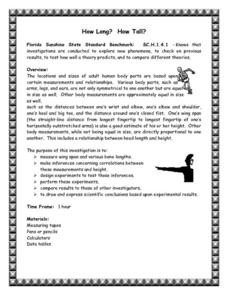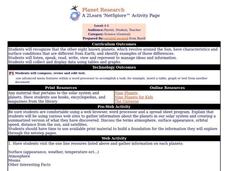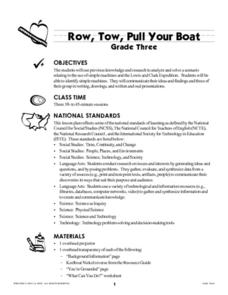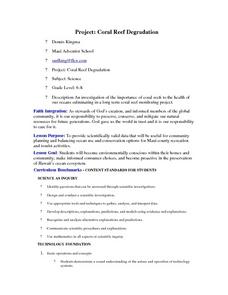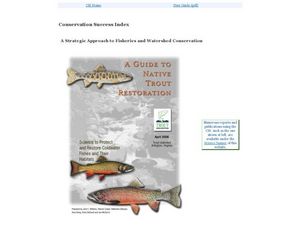Curated OER
Wh0-o-o-o's Out There?
Fifth graders describe the physical features of an owl and identify survival adaptations. They Investigate an owl's niche in an ecosystem. The students participate in an interactive puzzle on the internet that helps for motivation.
Curated OER
Converting Metric Units and Prefixes
Students investigate the length of various objects. In this measurement lesson, students convert one metric unit to another. They explain the importance of a uniform system of measurement.
Curated OER
Mapping a Stream
Students map an actual local waterway. They create full color scale drawings that include windfalls, plant cover, streambed composition, and landmarks such as trees, boulders, and slumps. This is a long-term project that involves...
Curated OER
Comparing Amount of Rainfall in Different Geographical Areas
Students construct rain gauges and use them to log rainfall in their school zone, local city, and region and then compare and discuss them by plotting this information.
Curated OER
How Long? How Tall?
Seventh graders investigate the parts of the human body and examine the symmetry of body parts like arms and legs. They measure the body parts and take individual height and weight to compare the quantities. Student examine whether the...
Curated OER
Miracle of Winged Migration
Students explore the life cycle of insects by researching butterflies. In this insect migration lesson plan, students identify the Monarch butterfly, where they inhabit, and what their migration consists of. Students utilize the Internet...
Curated OER
Planet Research
Students recognize that the other eight known planets, which revolve around the Sun, have characteristics and surface conditions that are different from Earth; and identify examples of those differences.
Curated OER
Sea Ice Research
Students study sea ice and its importance in climate and climate change. They discuss sea ice as a presence of a food source for marine animals in the arctic and complete a lab activity. After completing the lab, they watch a video...
Curated OER
Enzymes in Action: An Inquiry Approach to the Effects of Enzymes
Students experiment with enzymes as key components of chemical reactions in all living things through this series of lessons.
Curated OER
The Brine Shrimp Project
Tenth graders design and conduct a laboratory investigation to determine how different factors may affect the hatching and development of brine shrimp eggs.
Curated OER
Cosmic Collisions and Risk Assessment
In groups, young scholars create their own scientific impact experiments using ordinary materials, and observe and measure results with a variety of impacting bodies and velocities.
Curated OER
What's the Matter with My Orange?
Students use oranges to informally explore decomposition, dehydration, fermentation, the water cycle, bacteria, yeast, food webs, the needs of living things, and physical vs. chemical change over a period of three or more months.
Curated OER
Transmission of Disease
Students provide names of viral diseases that they would possibly like to be infected with today; listing them on the Smart Board. They then come to an agreement about what virus to use and use beakers of fluids to simulate how viruses...
Curated OER
Row, Tow, Pull Your Boat
Third graders use previous knowledge and research to analyze and solve a scenario relating to the use of simple machines and the Lewis and Clark Expedition. They present their findings to the class in oral presentations.
Curated OER
A Whirlwind Tour
Students explore volcanoes, hurricanes, and tornadoes through the use of the Internet.
Curated OER
Color Your World with Changes --- the Camouflage Game
Seventh graders, after predicting dominant colors foud in their habitat or garden, visit heir area on a monthly basis. They search for colored toothpicks, then graph the results, determining the dominant color for the month.
Curated OER
How Fast Does This Tree Grow?
Students work together to determine how fast trees go. They make predictions and complete simple measurements. They answer questions to end the lesson.
Curated OER
Water You Can Use from the Air Conditioner
Students work together to research water quantity, quality and safety standards. They complete a lab to discover how to use the water from an air conditioner. They write a paper to show their findings.
Curated OER
Coarl Reef Degradation
Students explore methods of preserving Hawaii's ocean ecosystem. Using underwater cameras, students take pictures of the underwater reef. They perform activities to determine the history and degradation of the coal reef. While...
Curated OER
Conservation Success Index
Learners read information about trout habitat preservation and visit the various links to learn a fish species and its current habitat range. In this habitat conservation lesson, students read passages about use the Trout Unlimited...
Curated OER
Forming a Hypothesis
For this hypothesis worksheet, students read about how to form a hypothesis and how to collect observations. Students go through the 4 steps of forming a hypothesis.
Curated OER
Creating a Salad Dressing
Young scholars investigate how the scientific process can be applied to making a new salad dressing recipe.
Curated OER
Oh, Give Them a Home!
Fourth graders study the habitat of the American bison and its role in the life of the Native Americans. They investigate how the bison effect the Lewis and Clark expedition.
Curated OER
Solving Saturn's Mysteries
Middle schoolers study the Cassini spacecraft and its travel to Saturn. They discover the results of the space mission and examine images of Saturn that Cassini sent back.




